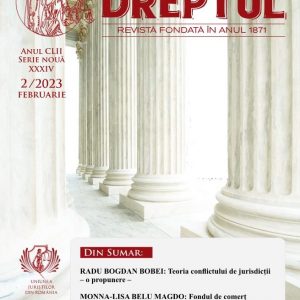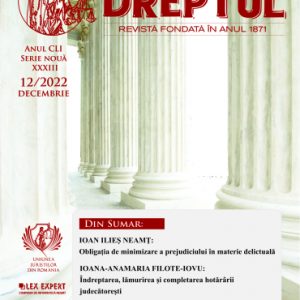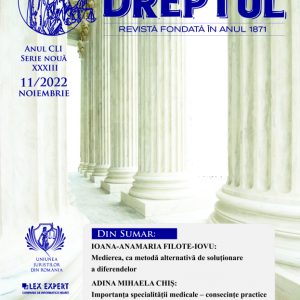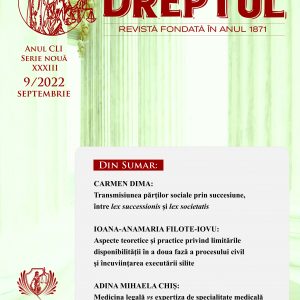-

-

-
 Pre-trial detention was defined as the most intrusive custodial preventive measure in the exercise of the person’s right to freedom, by which the judge or the court orders the detention of the defendant for the duration and under the specific conditions provided by law, in places specially intended for this purpose, in the interest of the criminal prosecution, the preliminary chamber procedure or the trial. In order to take pre-trial detention, it is necessary to meet all the general conditions provided by law for taking preventive measures, as well as the existence of at least one of the prev. of Article 223 of the Civil Procedure Code. In practice, in almost all cases, preventive arrest is based on the provisions of Article 223 (2) of the Civil Procedure Code. Under these conditions, we tried to create both a general presentation of these grounds and a theoretical analysis of the main issues that can generate confusion and problems in the application of the cases provided for by Article 223 (1) of the Civil Procedure Code. All this theoretical analysis has, as far as possible, been examined in conjunction with solutions from judicial practice, where appropriate.
Pre-trial detention was defined as the most intrusive custodial preventive measure in the exercise of the person’s right to freedom, by which the judge or the court orders the detention of the defendant for the duration and under the specific conditions provided by law, in places specially intended for this purpose, in the interest of the criminal prosecution, the preliminary chamber procedure or the trial. In order to take pre-trial detention, it is necessary to meet all the general conditions provided by law for taking preventive measures, as well as the existence of at least one of the prev. of Article 223 of the Civil Procedure Code. In practice, in almost all cases, preventive arrest is based on the provisions of Article 223 (2) of the Civil Procedure Code. Under these conditions, we tried to create both a general presentation of these grounds and a theoretical analysis of the main issues that can generate confusion and problems in the application of the cases provided for by Article 223 (1) of the Civil Procedure Code. All this theoretical analysis has, as far as possible, been examined in conjunction with solutions from judicial practice, where appropriate. -
 We are researching the mechanism of proof necessary for the application of the sanction of the automatic exclusion of statements obtained through torture or other ill -treatment contrary to Article 3 of the Convention. The topic has not yet been addressed in Romanian law, although it is of indisputable importance for the practical application of the sanction. Proof to a high standard of ill-treatment is essential to the normative force of the sanction. The difficulty of proving ill-treatment is the main impediment to its application in judicial practice. The resulting problem is solved by the European Court of Human Rights through a mechanism of proof that manages the legal consequences of uncertainty and does not lose sight of the requirement to find out the truth. This mechanism has three main components: The first is the requirement of an arguable claim about the ill-treatment, which is similar to the formal burden of proof (the burden of adducing evidence) in common law, with the difference that it is not imposed on a particular party, but is met if information about ill-treatment comes to the attention of the authorities in any way. The second is the obligation to effectively investigate this claim. The third is the substantial burden of proof or persuasive burden, which must be met to a certain standard of proof. Ill treatment must be proven by the party alleging it to the standard of proof beyond a reasonable doubt, but this standard can be met by corroborated presumptions. We present some typical presumptions applicable in situations frequently encountered in practice. Under Article 6 of the European Convention on Human Rights, the requirements of the fair trial may justify derogations from these general principles. For the automatic exclusion of statements, two cumulative conditions must be verified: the lack of an effective investigation and the real risk of ill-treatment.
We are researching the mechanism of proof necessary for the application of the sanction of the automatic exclusion of statements obtained through torture or other ill -treatment contrary to Article 3 of the Convention. The topic has not yet been addressed in Romanian law, although it is of indisputable importance for the practical application of the sanction. Proof to a high standard of ill-treatment is essential to the normative force of the sanction. The difficulty of proving ill-treatment is the main impediment to its application in judicial practice. The resulting problem is solved by the European Court of Human Rights through a mechanism of proof that manages the legal consequences of uncertainty and does not lose sight of the requirement to find out the truth. This mechanism has three main components: The first is the requirement of an arguable claim about the ill-treatment, which is similar to the formal burden of proof (the burden of adducing evidence) in common law, with the difference that it is not imposed on a particular party, but is met if information about ill-treatment comes to the attention of the authorities in any way. The second is the obligation to effectively investigate this claim. The third is the substantial burden of proof or persuasive burden, which must be met to a certain standard of proof. Ill treatment must be proven by the party alleging it to the standard of proof beyond a reasonable doubt, but this standard can be met by corroborated presumptions. We present some typical presumptions applicable in situations frequently encountered in practice. Under Article 6 of the European Convention on Human Rights, the requirements of the fair trial may justify derogations from these general principles. For the automatic exclusion of statements, two cumulative conditions must be verified: the lack of an effective investigation and the real risk of ill-treatment. -
 In this study, the author, emphasizing the difficulties encountered by judicial practice in the use, interpretation and application of law enforcement, clarification and completion of judgments, wishes to clarify these procedures, proposing some legislative changes to ensure clarity of incident rules. Thus, situations are presented in which, by means of a request for correction, misjudgments have been corrected, or both requests for clarification of the decision and a title appeal have been formulated, as well as doctrinal controversies regarding the right of option of the party between the procedure for completing the decision and the appeal for review.
In this study, the author, emphasizing the difficulties encountered by judicial practice in the use, interpretation and application of law enforcement, clarification and completion of judgments, wishes to clarify these procedures, proposing some legislative changes to ensure clarity of incident rules. Thus, situations are presented in which, by means of a request for correction, misjudgments have been corrected, or both requests for clarification of the decision and a title appeal have been formulated, as well as doctrinal controversies regarding the right of option of the party between the procedure for completing the decision and the appeal for review. -
 In this study the author analyzes the victim’s obligation to minimize the damage in the context of a hypothesis of tort civil liability. In this sense, after a short introductory part intended to set the framework of the analysis, the author proposes to identify what would be the normative provisions from which the victim’s obligation to minimize the damage would derive, emphasizing the fact that, despite the lack of a clear and unequivocal rule in this sense, the existence of the obligation still derives from a whole series of legal provisions. The particularities of the obligation to minimize the damage are further addressed, its general legal regime being decrypted, with emphasis on those aspects that distinguish and individualize it in relation to other legal institutions, but also its mode of operation. Likewise, the author aims to identify the legal nature of the obligation to minimize the damage, underlining the limits of the theses advanced so far and showing why the obligation is a sui generis one. Further on, there are emphasized the consequences produced by the obligation to minimize the damage, whether respected by the victim or not, and in the end there are presented brief considerations referring to his procedural regime.
In this study the author analyzes the victim’s obligation to minimize the damage in the context of a hypothesis of tort civil liability. In this sense, after a short introductory part intended to set the framework of the analysis, the author proposes to identify what would be the normative provisions from which the victim’s obligation to minimize the damage would derive, emphasizing the fact that, despite the lack of a clear and unequivocal rule in this sense, the existence of the obligation still derives from a whole series of legal provisions. The particularities of the obligation to minimize the damage are further addressed, its general legal regime being decrypted, with emphasis on those aspects that distinguish and individualize it in relation to other legal institutions, but also its mode of operation. Likewise, the author aims to identify the legal nature of the obligation to minimize the damage, underlining the limits of the theses advanced so far and showing why the obligation is a sui generis one. Further on, there are emphasized the consequences produced by the obligation to minimize the damage, whether respected by the victim or not, and in the end there are presented brief considerations referring to his procedural regime. -

-
 Active procedural quality and interest are essential conditions for promoting any action in court. The verification of the two conditions must be carried out from the outset, firstly, by the person or persons initiating an action in court and, secondly, by the court which is invested with resolving the action. The lack of one of the two conditions paralyzes the resolution of the action on the merits and attracts the rejection of the action, either as being introduced by a person lacking procedural quality, or as being without interest. It is not often that in the defenses formulated by the defendant the exception of the lack of active procedural capacity and the exception of the lack of interest are invoked at the same time. Concomitant invocation is often natural, as procedural quality and interest are two elements which, although not confusing, often justify each other. However, I have encountered in practice multiple situations in which the active procedural capacity has been justified by the applicant’s/applicants’ interest in promoting the action. On the other hand, there may be situations, less common in practice, in which the interest is justified by the procedural quality. Here that the two basic elements of any action or lawsuit are often indissoluble, and their concomitant treatment appears natural. That is why I considered it opportune to carry out a brief study on how the interest justifies the active procedural quality, with references to certain solutions encountered in judicial practice or to solutions that had as inspiration the invocation of exceptions, thus trying to argue which, on the one hand, the two exceptions are invoked together, most of the time and, on the other hand, why, in a particular way, the interest justifies the procedural quality. At the same time, the study includes a comparison between the situations in which the interest is analyzed as an exception and the situations in which the interest must be analyzed on the merits.
Active procedural quality and interest are essential conditions for promoting any action in court. The verification of the two conditions must be carried out from the outset, firstly, by the person or persons initiating an action in court and, secondly, by the court which is invested with resolving the action. The lack of one of the two conditions paralyzes the resolution of the action on the merits and attracts the rejection of the action, either as being introduced by a person lacking procedural quality, or as being without interest. It is not often that in the defenses formulated by the defendant the exception of the lack of active procedural capacity and the exception of the lack of interest are invoked at the same time. Concomitant invocation is often natural, as procedural quality and interest are two elements which, although not confusing, often justify each other. However, I have encountered in practice multiple situations in which the active procedural capacity has been justified by the applicant’s/applicants’ interest in promoting the action. On the other hand, there may be situations, less common in practice, in which the interest is justified by the procedural quality. Here that the two basic elements of any action or lawsuit are often indissoluble, and their concomitant treatment appears natural. That is why I considered it opportune to carry out a brief study on how the interest justifies the active procedural quality, with references to certain solutions encountered in judicial practice or to solutions that had as inspiration the invocation of exceptions, thus trying to argue which, on the one hand, the two exceptions are invoked together, most of the time and, on the other hand, why, in a particular way, the interest justifies the procedural quality. At the same time, the study includes a comparison between the situations in which the interest is analyzed as an exception and the situations in which the interest must be analyzed on the merits. -
 The loss of the chance to obtain an advantage or to avoid a damage represents a new form of reparation of prejudice regulated by the Civil Code, enshrined by the provisions of Article 1385 (4) of the Civil Code, and represents a distinct category of prejudice reparable by engaging in tort civil liability, which concerns those negative consequences directly caused by the commission of an illegal act that consist in missing the real and serious possibility of the occurrence of a favourable event for the victim’s life, which could have brought him fulfilment in his personal or economic life by the carrying out of some projects. Therefore, the loss of a chance means the loss by a person of the possibility to achieve a gain or, as the case may be, to avoid a damage, which may result in causing a prejudice to that person. De lege lata, we mention that the prejudice caused by the „loss of the chance to obtain an advantage” can be invoked within the framework of tort (extra-contractual) civil liability, but also in the field of contractual civil liability whenever by the non-fulfilment of the legal or contractual obligations such consequences have occurred. This prejudice could be claimed both by the direct victim of an illegal act and by those close to them if they prove that they suffered, through ricochet, such a prejudice. In order to have a reparable prejudice, the chance of occurrence of the favourable event for the victim must be as real as it is serious, which is assessed differently, whether or not the victim was in the process of taking the chance at the time when the event that compromised the possibility to achieve it occurred, and this prejudice must be in a direct causal link with the illegal act committed by the responsible person. The assessment of the chance shall be carried out in relation with two criteria, namely the examination of the circumstances in which the illegal act was committed, on the one hand, and the special situation in which the victim was at that time, on the other hand. With regard to the features of the prejudice, we specify that it must be certain (certain, unquestionable) and real (undeniable, effective, indisputable), and not an eventual one (possible, probable), the loss, therefore, must be actual.
The loss of the chance to obtain an advantage or to avoid a damage represents a new form of reparation of prejudice regulated by the Civil Code, enshrined by the provisions of Article 1385 (4) of the Civil Code, and represents a distinct category of prejudice reparable by engaging in tort civil liability, which concerns those negative consequences directly caused by the commission of an illegal act that consist in missing the real and serious possibility of the occurrence of a favourable event for the victim’s life, which could have brought him fulfilment in his personal or economic life by the carrying out of some projects. Therefore, the loss of a chance means the loss by a person of the possibility to achieve a gain or, as the case may be, to avoid a damage, which may result in causing a prejudice to that person. De lege lata, we mention that the prejudice caused by the „loss of the chance to obtain an advantage” can be invoked within the framework of tort (extra-contractual) civil liability, but also in the field of contractual civil liability whenever by the non-fulfilment of the legal or contractual obligations such consequences have occurred. This prejudice could be claimed both by the direct victim of an illegal act and by those close to them if they prove that they suffered, through ricochet, such a prejudice. In order to have a reparable prejudice, the chance of occurrence of the favourable event for the victim must be as real as it is serious, which is assessed differently, whether or not the victim was in the process of taking the chance at the time when the event that compromised the possibility to achieve it occurred, and this prejudice must be in a direct causal link with the illegal act committed by the responsible person. The assessment of the chance shall be carried out in relation with two criteria, namely the examination of the circumstances in which the illegal act was committed, on the one hand, and the special situation in which the victim was at that time, on the other hand. With regard to the features of the prejudice, we specify that it must be certain (certain, unquestionable) and real (undeniable, effective, indisputable), and not an eventual one (possible, probable), the loss, therefore, must be actual. -
 The continuation of the criminal trial is a form of exercising the right of defence through which, in the cases expressly and limitingly provided by law, the suspect or defendant causes an increase in procedural activity after extinguishing the criminal action in order to unequivocally establish his innocence. This procedure, which is the subject of this study, was established to guarantee the presumption of innocence of the suspect or defendant in the event that the criminal action is extinguished as a result of certain impediments provided by Article 16 of the Criminal Procedure Code. These impediments are: the existence of a cause of imputability, the intervention of the pre-conviction amnesty, the intervention of the prescription of criminal liability, the withdrawal of the preliminary complaint and the existence of a cause of impunity. These situations are limited.
The continuation of the criminal trial is a form of exercising the right of defence through which, in the cases expressly and limitingly provided by law, the suspect or defendant causes an increase in procedural activity after extinguishing the criminal action in order to unequivocally establish his innocence. This procedure, which is the subject of this study, was established to guarantee the presumption of innocence of the suspect or defendant in the event that the criminal action is extinguished as a result of certain impediments provided by Article 16 of the Criminal Procedure Code. These impediments are: the existence of a cause of imputability, the intervention of the pre-conviction amnesty, the intervention of the prescription of criminal liability, the withdrawal of the preliminary complaint and the existence of a cause of impunity. These situations are limited. -
 Against the background of the interpenetration of the forms of legal liability for the same illicit deed, whether it is criminal, administrative, contraventional or disciplinary liability, in conjunction with the case law of the European courts attributing criminal character to some accusations beyond the legal qualification of the deed in the domestic law, a double criminal liability may be reached, thus posing the problem of the cumulation of these liabilities in terms of respecting the right not to be punished twice (ne bis in idem). Although no matter can be an exception, the issue arises mainly in areas where there are various forms of liability in the domestic law and different authorities with supervisory and sanctioning powers, such as tax evasion, public order, forestry or environmental offences or, finally, labour protection, which is of interest here. Thus, in the field of safety and health at work, the employer’s liability in the event of accidents at work may be exemplary for such situations, given that he is liable for both a criminal liability incurred by the judicial bodies and a contraventional liability established by the special bodies of the labour inspection, following that our approach will address this issue in the context of the current case law of the European courts of law (such as Case A and B v. Norway, Grand Chamber of the E.C.H.R., or the C.J.E.U. cases, Luca Menci, Garlsson Real Estate SA and Enzo Di Puma, Consob).
Against the background of the interpenetration of the forms of legal liability for the same illicit deed, whether it is criminal, administrative, contraventional or disciplinary liability, in conjunction with the case law of the European courts attributing criminal character to some accusations beyond the legal qualification of the deed in the domestic law, a double criminal liability may be reached, thus posing the problem of the cumulation of these liabilities in terms of respecting the right not to be punished twice (ne bis in idem). Although no matter can be an exception, the issue arises mainly in areas where there are various forms of liability in the domestic law and different authorities with supervisory and sanctioning powers, such as tax evasion, public order, forestry or environmental offences or, finally, labour protection, which is of interest here. Thus, in the field of safety and health at work, the employer’s liability in the event of accidents at work may be exemplary for such situations, given that he is liable for both a criminal liability incurred by the judicial bodies and a contraventional liability established by the special bodies of the labour inspection, following that our approach will address this issue in the context of the current case law of the European courts of law (such as Case A and B v. Norway, Grand Chamber of the E.C.H.R., or the C.J.E.U. cases, Luca Menci, Garlsson Real Estate SA and Enzo Di Puma, Consob). -
 Globalization, the changing concepts of the family definition and the emergence of new medical techniques for conceiving children have led to the emergence of substitution maternity and the issue of inheritance rights for children born of such a procedure. At international level, no comparable moral or legal basis can be identified in this area. The creation of a common legal framework or the advancement of a large-scale international unification of substantive law or rules on the recognition of the effects of foreign laws seems to be a distant goal to achieve. The issue of the inheritance rights of children born of surrogacy motherhood is a very complex one and currently without legislative protection. On European Union level, European Regulation 650/2012 has been in force since 2012, but there are no provisions on the situation of inheritance rights deriving from a surrogacy contract. The study aims to analyse the general concepts recognised in international, European and national law with regard to the creation of a legal framework as structured as possible for the protection of the inheritance rights of children born of substitution maternity, and to understand how this medical practice works. Another objective will be to analyse the decisions of the European Court of Human Rights, the decisions of the Court of Justice of the European Union and the national courts decisions, in order to find solutions on how to protect inheritance rights in such a situation.
Globalization, the changing concepts of the family definition and the emergence of new medical techniques for conceiving children have led to the emergence of substitution maternity and the issue of inheritance rights for children born of such a procedure. At international level, no comparable moral or legal basis can be identified in this area. The creation of a common legal framework or the advancement of a large-scale international unification of substantive law or rules on the recognition of the effects of foreign laws seems to be a distant goal to achieve. The issue of the inheritance rights of children born of surrogacy motherhood is a very complex one and currently without legislative protection. On European Union level, European Regulation 650/2012 has been in force since 2012, but there are no provisions on the situation of inheritance rights deriving from a surrogacy contract. The study aims to analyse the general concepts recognised in international, European and national law with regard to the creation of a legal framework as structured as possible for the protection of the inheritance rights of children born of substitution maternity, and to understand how this medical practice works. Another objective will be to analyse the decisions of the European Court of Human Rights, the decisions of the Court of Justice of the European Union and the national courts decisions, in order to find solutions on how to protect inheritance rights in such a situation.
